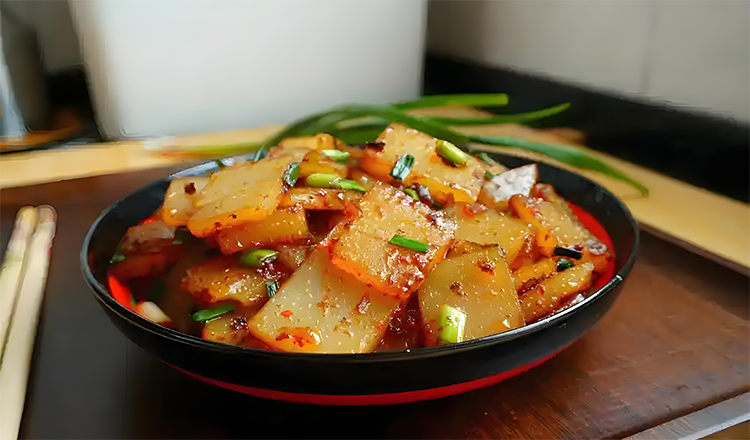Where to Eat Kaifeng’s Stir-Fried Mung Bean Jelly (Liangfen) at Night Markets
1. Kaifeng Stir-Fried Liangfen: A Bowl of Soft, Savory Street Flavor
Imagine strolling Kaifeng’s bustling night markets as lanterns glow and the air fills with sizzling aromas. Among the many scents, a rich fermented sauce with a slight char draws you in. Follow it and you’ll find a busy stall: a large iron wok hissing, the vendor skillfully stirring translucent jelly-like blocks. Coated in a glossy red sauce, these pieces are Kaifeng’s signature street snack—stir-fried liangfen. Unpretentious yet deeply rooted in local life, this simple dish captures the warmth and flavor of the ancient city.
2. Origins in the Northern Song: A Tasty Accident Turned Tradition
Stir-fried liangfen traces back to Kaifeng’s heyday as the Northern Song capital, when the city—then called Bianliang—was one of the world’s busiest urban centers. Liangfen, a jelly made from mung-bean starch, was already common on ordinary tables. Local legend says a vendor accidentally dropped a piece of cold liangfen into a hot wok while cooking. Instead of discarding it, they tasted the result: warmed, slightly crisp at the edges, and far more aromatic than the cold version. That happy accident spread, and generations of street cooks refined the recipe, adding Kaifeng’s characteristic watermelon bean paste and other local seasonings to create the stir-fried liangfen we enjoy today.

3. The Heart of Kaifeng Life: A Beloved Everyday Snack
In Kaifeng, stir-fried liangfen is more than food—it’s a cultural emblem. Affordable and quick to prepare, it’s a favorite after-school snack for students, a convenient bite for commuters, and a must-try for visitors. Evenings at Drum Tower and Xisi night markets often feature long queues of locals holding disposable boxes, standing or sitting while they savor every bite. Eating liangfen beside the wok, amid chatter and clatter, is one of Kaifeng’s most vivid street-life experiences.
For locals, the taste of stir-fried liangfen evokes home: a simple, hearty flavor that reflects the city’s friendly, unpretentious spirit. Tasting it offers a direct, sensory connection to Kaifeng’s everyday culture.
4. Ingredients and Flavor: Simple Components, Complex Taste
– Main ingredient: liangfen. Authentic Kaifeng liangfen is made from mung-bean starch. High-quality liangfen is firm and elastic, translucent gray-white, and holds together well during stir-frying so it absorbs sauce without falling apart.
– Flavor backbone: fermented bean sauce. The dish’s depth comes from Kaifeng’s local watermelon bean paste or well-fermented douchi. These sauces provide a savory, slightly sweet umami base. Scallions, chopped garlic, and ginger are stir-fried to build aroma, while chili adds a gentle heat.
– Final dish: look for glossy red sauce, soft but springy liangfen pieces, and a hint of crisped edges. The first bite delivers salty-savory richness, followed by the fermented paste’s mellow depth, the pungency of garlic and scallion, and a mild chili warmth. The chewy, smooth liangfen balances these strong flavors, making each mouthful addictive.

5. How to Taste It Like a Local
Watch the vendor’s technique—an experienced cook turns the liangfen blocks with a spatula, cutting them into bite-sized pieces and tossing them quickly so the sauce clings evenly. The final flourish is using the wok’s residual heat to crisp some pieces into a golden, crunchy edge called “ge”—the treasured bit every local seeks.
When you receive your boxed portion, let the steam ease for a moment. Then mix gently so some of the crispy edges mingle with the soft interior. Eat each bite with its contrast of textures and flavors. Locals often pair liangfen with a baked sesame flatbread (shaobing), using it to scoop up the hot pieces—an especially satisfying combination.
6. Where and When to Try It
– Where: Drum Tower Square night market and Xisi Square night market have the highest concentration of liangfen stalls. Follow queues of locals—long lines usually mean great flavor.
– When: Evening and night—stalls open around 5–6 PM and stay busy into the late hours. Liangfen is an ideal night-market snack.
– How to order: Say “One stir-fried liangfen, please” or ask for “more spicy” or “no spice” as you prefer. A typical portion costs around 10–15 RMB.
– Pairings: Try it with almond tea or jiangmi sweet rice wine for a sweet counterpoint that balances the savory, slightly spicy liangfen.

7. Simple Home Recipe to Recreate Kaifeng Liangfen
Ingredients:
block liangfen (from Asian supermarkets), chopped scallion, minced garlic and ginger, douban or fermented bean paste, light soy, a splash of dark soy for color, pinch of sugar, oil.
Steps:
1. Cut liangfen into 2–3 cm cubes.
2. Heat oil, stir-fry the fermented paste until fragrant and it releases red oil.
3. Add scallion, garlic, and ginger to bloom the aroma.
4. Add liangfen and toss gently over medium-high heat to avoid breaking the pieces.
5. Add light soy, a touch of dark soy, and a pinch of sugar; continue to toss until evenly coated and heated through.
6. For crispy edges, press some pieces against the wok to sear lightly.
7. Finish with fresh scallion and serve hot.
A steaming box of stir-fried liangfen is Kaifeng’s warm, honest gift to travelers. It’s not elaborate, but its texture and savory layers tell the story of a city shaped by centuries of daily life. When you visit Kaifeng, leave time to wander a night market, find a steaming wok, and taste this unforgettable local specialty—standing among locals, savoring a bite that captures the heart of central China.


